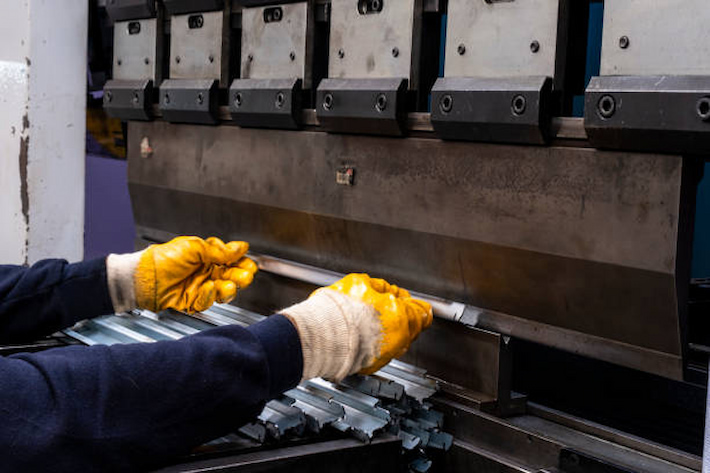Anyone who’s familiar with even mild metal fabrication knows that the fabrication process doesn’t begin with pressing, bending or welding: it begins with cutting. Metal plates, sheets, and even foils need to be cut and shaped before they’re joined or finished, and these are tasks reserved for guillotines and shears.
Whether it’s a small quantity of hand cut panels for a custom fabrication job, or a high volume run of steel architectural elements for a major construction project, having the cleanest, and most precise stock cuts is arguably the most important operation in the manufacturing process. Poor cuts ultimately mean poor fit, which is why we suggest getting ahead of the quality curve by investing in the best available cutting machinery for each of your cutting jobs.
Guillotines are the Key to Your Precision Cutting Jobs
From one-man, treadle-operated machines with 1270mm cutting capacities, to heavy duty, machine-fed behemoths with 4000mm maws, high-precision sheet metal guillotines and shears are some of the most essential pieces of machinery used in modern manufacturing. Today’s automated, multi-operation manufacturing processes are more precision-driven than ever, and that’s not just because of tighter finished product tolerances.
Complex, automated secondary machine set-ups now require businesses to use only the most precise, burr-free feed stock. This means the sheets and blanks you’re feeding them, whether they’re cut by hand or mechanically, need to be cut as accurately, and as cleanly as possible.
Sheet Metal Guillotines and Shears for Every Capacity
No matter the size of your business, or the type of stock you need to fabricate, there are sheet metal guillotines for sale to suit any process or capacity, including:
- Manual treadle shears. These hand and foot operated metal processors are ideal for mild steels and non-ferrous metals up to 1.6mm thick.
- Air-powered pneumatic shears. Pneumatic shears are the best choice for fast, high speed cuts on 1.6mm thick metals.
- Electro-hydraulic shears and guillotines. These fluid-actuated cutters are engineered to apply even, high processing pressures to metals up to 4mm thick.
- Hydraulic swing beam guillotines. These specialised cutters are designed to apply cutting pressure to a single point on the metal stock before transferring full pressure across the entire stock.
- Variable rake guillotines. A variable rake guillotine for metal sheet processing features an adjustable top beam that gives operators maximum control over cut styles, while minimising stock deformation.
With such a wide range of shear and guillotine options to choose from, fabricators, manufacturers, and other metal working businesses are limited only by their operational throughput and quality requirements. A large part of cutter performance depends on the basic operation of the metal guillotine machine itself, though; and, in particular, how the blade is designed to perform the cut.
Recognising the Difference Between Guillotines and Shears

Although most types of industrial cutting machines tend to be referred to collectively as either guillotines or shears, there are very specific differences between them. Shears utilise a diamond-shaped upper blade that moves in a circular arc, effectively shearing away sheets of metal as one blade moves past the other. Guillotines, however, rely on a perfectly off-set upper blade moving up and down in a vertical line that slices the metal.
Blade motion isn’t the only difference between them, though. Shears are naturally better at making quick cuts into thin non-ferrous metals that don’t require absolute precision. The straightline action of a sheet metal guillotine, however, offers its own bevy of processing benefits that include:
- Unparalleled precision with adjustable, burr-free cutting edges;
- The ability to process larger quantities, as well as wider ranges and thicknesses of metal; and,
- A longer blade life, that can be rapidly swapped out for differing edge profiles.
And not only does a guillotine’s ability to work within closer tolerances potentially reduce the number of cutting passes that may be necessary before moving to the next operation, it dramatically reduces the amount of trim and material waste that’s generated during processing. Ideally, when making guillotine sheet metal falloff calculations, procurement departments are able to reduce the amount of raw material they have to order before a production run – a huge advantage when working high cost metals, as well as metals with long lead-times.
Meet the Hardest Working Guillotines in Australia
Make no mistake: with guillotines being the industry’s premier high volume production metal processors, it’s understandable that a variable rake machine would be the sheet metal guillotine Australia turns to most for its biggest processing jobs. These heavy duty guillotines are used in all types of automotive, fabrication, and general manufacturing facilities throughout the country.
With their ability to process stock up to 13mm thick, no other type of automated cutter is better equipped to handle more types of metal sheets, plates, and profiles. Precision, productivity, and user friendly features are the standard for these high-precision guillotines, and to accommodate their full-sized 4000mm rakes, they offer an array of operational attributes that include:
- CNC touch screen controls with angle blade settings;
- Laser line cutting displays for operators;
- Multiple edge quality cutting blades and squaring arms;
- Front angle gauge with calibrated settings; and,
- Heavy-duty ball transfers for fast, efficient stock feeding and removal.
And when it comes to safety, these powerful, hard working guillotines are also fitted with safety cutoff guards and remote operation foot-pedal emergency stops. That means even when you’re ramping up production, a variable rack sheet metal guillotine machine is built to prevent the kinds of hasty operator entanglements that could result in deep cuts or injuries.
The Final Word
When it comes to increasing quality and throughput, while reducing processing time and waste, high-precision sheet metal guillotines and shears are the machines that can help businesses meet their objectives. They make it possible to get ahead of the curve.
At the end of the day, manufacturers and fabricators alike are always going to find themselves under pressure to improve their processes. Not surprisingly, the leading edge of the workflow is where the most significant improvements can be made; and that’s where the principle metal cutting takes place.



